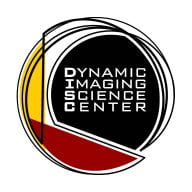Our center utilizes a research-dedicated high-performance 0.55T MRI system (supported by NSF Grant #MRI-1828736) located in the Michelson Center for Convergent Biosciences, which is USC’s flagship biomedical research building on our University Park Campus. Note that Siemens recently announced their next-generation MAGNETOM Free.MaxTM system will operate at the same 0.55T field strength.
System and Console
This system is a Siemens Aera MRI. It includes zero helium boil-off technology, advanced MR gradient technology including a high-performance 100% duty-cycle shielded “XQ” gradient coil (45mT/m, 200mT/m/ms – on each axis), enhanced gradient amplifiers, 48-channel fast receiver (2µs sampling), passive/active shims, a 70 cm bore, and total integrated matrix (TIM) integrated receiver coil technology.
The key attributes of this system are:
1) high performance shielded gradients;
2) stable and proven design;
3) comprehensive and versatile scan options;
4) simplified scan planning and high productivity (“DOT” engine);
5) noise reduction measures such as epoxy-resin cast gradients and acoustically damped mountings;
6) ease of customizing pulse sequences (IDEA programming environment);
7) ease of customizing image reconstruction (ICE programming environment);
8) main field homogeneity <0.5 ppm for 30cm field-of-view.
System Modifications: This system was originally designed to operate at 1.5 Tesla. Siemens engineers custom modified the system to make it operate at 0.55 Tesla. The main magnetic field was ramped to 0.55 Tesla, and manually shimmed. The whole-body transmit/receive birdcage RF coil was replaced by one that is tuned to 23.6 MHz (1H at 0.55T). The RF amplifier was replaced with one designed for 23.6 MHz. All receiver coils were designed for 23.6 MHz.
Subject Friendly
The physical space of the Dynamic Imaging Science Center was professionally designed to be subject friendly. Subjects enter through a comfortable lounge/reception area, which includes a private area for screening and obtaining informed consent. There is an attached changing area with lockers. There is an attached ADA compliant restroom. For metal screening, we have installed a sensitive and easy-to-use pillar system, and secondary wand system FerrAlertTM SOLO and Target Scanner.
Custom Receiver Coils
In addition to the transmit-receive body coil, this system is equipped with several custom RF receive-only coils tuned to 23.6 MHz:
1) 6-channel body array;
2) 18-channel spine array,
3) 12-channel head and neck array;
4) 8-channel upper airway array.
The first three coils were provided by Siemens, and the fourth is being provided by Stark Contrast LLC, Erlangen, Germany, with an expected delivery of May 2021.
Methods Development
A collaborative research agreement with Siemens Healthcare provides our group with access to pulse sequence (IDEA) and reconstruction (ICE) development environments. We receive a high-level of technical support, including an FTE Siemens scientist who has been on-site since February 2020, continuous hardware and software upgrades as well as access to the latest Siemens imaging and postprocessing software.
Real-Time System
This system includes a RTHawk real-time interactive system (HeartVista, Inc., Los Altos, CA) that is capable of gathering raw data from the scanner and reconstructing and displaying images with minimal latency. The system provides a programmable user interface that allows interactive changes to acquisition and pulse sequence parameters (e.g. scan plane, field-of-view, flip angle, spatial resolution, slice thickness).
Reconstruction and Machine Learning Workstation
This system is connected to a LAMBDA Hyperplane 4-A100 accelerated computing system that is used for real-time reconstruction (including GPU-intense methods utilizing constraints and/or machine learning). It can also be used for automated image processing, analysis, and interpretation. It has 32 CPU cores, 4x NVIDIA A100 SXM2 Tensor Core GPUs (40 Gb), 512 GBs of system memory, 512 GBs of GPU memory, and 3.84 TBs of storage capacity.
Physiological Monitors
The imaging suite will include several in-bore physiological monitoring systems including: 1) a Brain Vision 32-channel MRI-compatible EEG system. 2) an OptoAcoustics FOMRI-III audio communication, de-noising, and recording system; and 3) a BioPAC physiological monitor to record heart rate, respiration, respiratory effort, and facemask pressure during experiments.






